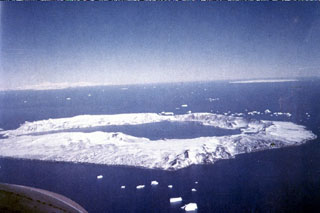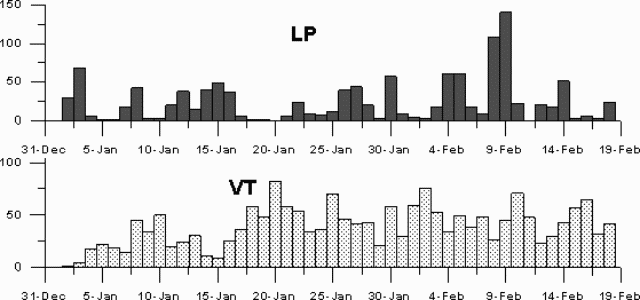Report on Deception Island (Antarctica) — May 1999
Bulletin of the Global Volcanism Network, vol. 24, no. 5 (May 1999)
Managing Editor: Richard Wunderman.
Deception Island (Antarctica) Annual short-term monitoring finds enhanced 1999 seismicity
Please cite this report as:
Global Volcanism Program, 1999. Report on Deception Island (Antarctica) (Wunderman, R., ed.). Bulletin of the Global Volcanism Network, 24:5. Smithsonian Institution. https://doi.org/10.5479/si.GVP.BGVN199905-390030
Deception Island
Antarctica
62.9567°S, 60.6367°W; summit elev. 602 m
All times are local (unless otherwise noted)
Deception has been monitored for part of every austral summer since 1987; its flooded caldera forms a 5 x 9 km bay that is breached to the SW, giving Deception Island a ring shape. In December 1998, as part of the Spanish Antarctic Research Project, a new seismic network was deployed to monitor activity on the island. The instrumentation included two seismic antennas and two continuous-recording stations.
The latest seismic survey was conducted under the auspices of the Spanish Antarctic Project; it revealed a significant increase in the daily number of seismic events (i.e., volcano-tectonic (VT) earthquakes, volcanic tremor, and long-period (LP) events when compared with activity recorded during previous summer field surveys. The noteworthy increase started in early January 1999 (BGVN 24:01) and continued in February (figure 14).
The active area is in a region between Fumarolic Bay and Murature Point and the seismic activity appears to be located near the boundary of the geological structure activated by the 1970 eruption.
The focal depth of the seismic events was shallow (less than 1 km). The seismic energy release was higher than observed in the recent past, and a few shocks were felt. The maximum magnitude of the VT earthquakes is estimated to be ~3.5. Some episodes of volcanic tremor were felt by the scientific staff while working close to the site at Murature Point. An anomalous increase of dead krill was noticed in the bay a few days before the seismic crisis.
Members of the project interpreted these observations in the following manner: A fresh intrusion of magma occurred at a depth of ~500 m. The VT earthquakes are the brittle response of the shallow structure surrounding this injection, and the LP events and volcanic tremor result from the interaction of the shallow aquifer of the island with this injection of hot material. This implies a significant evolution of activity, marked by a change from stable stationary geothermal processes to a more dynamic intrusive process.
Geological Summary. Ring-shaped Deception Island, at the SW end of the South Shetland Islands, NE of Graham Land Peninsula, was constructed along the axis of the Bransfield Rift spreading center. A narrow passageway named Neptunes Bellows provides an entrance to a natural harbor within the 8.5 x 10 km caldera that was utilized as an Antarctic whaling station. Numerous vents along ring fractures circling the low 14-km-wide island have been reported active for more than 200 years. Maars line the shores of 190-m-deep Port Foster caldera bay. Among the largest of these maars is 1-km-wide Whalers Bay, at the entrance to the harbor. Eruptions during the past 8,700 years have been dated from ash layers in lake sediments on the Antarctic Peninsula and neighboring islands.
Information Contacts: Jesus Ibañez, Gerardo Alguacil, José Morales, José Peña, Javier Almendros and Enrique Carmona, Instituto Andaluz de Geofísica, Univ. de Granada, Spain; Alicia Garcia and Ramón Ortiz, Dpto. de Volcanologia, MNCN-CSIC, José Gutierrez Abascal 2, 28006 Madrid, Spain; Edoardo del Pezzo and Marcello Martini, Osservatorio Vesuviano, Napoles, Italy; Bernard Chouet, USGS, Menlo Park, CA 94025 USA; Gilberto Saccorotti, Univ. Salerno, 84100 Baronissi (Salerno), Italy.


